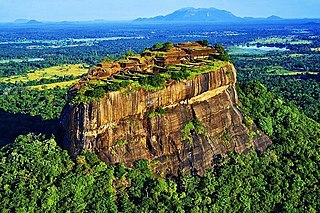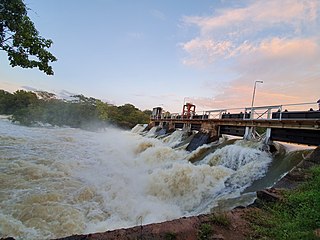
Mahāvaṃsa (Sinhala: මහාවංශ, Pali: මහාවංස is the meticulously kept historical chronicle of Sri Lanka until the period of Mahasena of Anuradhapura. It was written in the style of an epic poem written in the Pali language. It relates the history of Sri Lanka from its legendary beginnings up to the reign of Mahasena of Anuradhapura covering the period between the arrival of Prince Vijaya from India in 543 BCE to his reign and later updated by different writers. It was first composed by a Buddhist monk at the Mahavihara temple in Anuradhapura in the 5th or 6th century CE.

Sigiriya or Sinhagiri is an ancient rock fortress located in the northern Matale District near the town of Dambulla in the Central Province, Sri Lanka. It is a site of historical and archaeological significance that is dominated by a massive column of granite approximately 180 m (590 ft) high.

Tissa, later Devanampiya Tissa, was one of the earliest kings of Sri Lanka based at the ancient capital of Anuradhapura. According to the traditional chronology, he ruled from 307 BC to 267 BC, but the modified chronology adopted by modern scholars such as Wilhelm Geiger assigns his reign to 247 BC to 207 BC. His reign was notable for the arrival of Buddhism in Sri Lanka under the aegis of the Mauryan Emperor Ashoka the Great. The primary source for his reign is the Mahavamsa, which in turn is based on the more ancient Dipavamsa.

The Tissamaharama Raja Maha Vihara is an ancient Buddhist temple in Tissamaharama, Southern Province of Sri Lanka. It was one of the four major Buddhist monasteries established in Sri Lanka, after the arrival of Arhant Mahinda Thera to the country. The site of the Tissamaharama Raja Maha Vihara was consecrated by Buddha himself, who spent some time in meditation there with 500 arhats, during his third visit to the island. Tissamaharama monastery had been recognized as a pre-eminent Buddhist educational center of the southern Sri Lanka from the 3rd century B.C. to the 11th century A.D. The Tissamaharama Dagoba which is situated in the premises of the monastery is one of the largest stupas in Sri Lanka. The present chief incumbent of Tissamaharama Raja Maha Vihara is Ven. Devalegama Dhammasena Nayaka Thera.
The ancient Sri Lankan people, which consisted of Sinhalese and Sri Lankan Tamils excelled in the construction of tanks (Wevas) or reservoirs, dagobas, Hindu temples and palaces in Sri Lanka, as evident from the ruins which displays a rich variety of architectural forms.

Parākramabāhu I, or Parakramabahu the Great, was the king of Polonnaruwa from 1153 to 1186. He oversaw the expansion and beautification of his capital, constructed extensive irrigation systems, reorganised the country's army, reformed Buddhist practices, encouraged the arts and undertook military campaigns in South India and Burma. The adage, "Not even a drop of water that comes from the rain must flow into the ocean without being made useful to man" is one of his most famous utterances."

Vijayabahu I, also known as Vijayabahu the Great, was a medieval king of Sri Lanka. Born to a royal bloodline, Vijayabahu grew up under Chola occupation. He assumed rulership of the Ruhuna principality in the southern parts of the country in 1055. Following a seventeen-year-long campaign, he successfully drove the Cholas out of the island in 1070, reuniting the country for the first time in over a century. During his reign, he re-established Buddhism in Sri Lanka and repaired much of the damage caused to infrastructure during the wars. He offered the Thihoshin Pagoda(Lord of Sri Lanka Buddha image) to Burma king Alaungsithu and it is now still in Pakokku.

Kala Wewa built by the King Datusena in 460 A.D, is a twin reservoir complex which has a capacity of 123 million cubic meters. This reservoir complex has facilitated with a stone made spillway and three main sluices. From the central major sluice, a 40 feet wide central conveys water to feed thousands of acres of paddy lands and ends at the historical capital Anuradhapura city tank Tissa Wewa meandering over 87 km (54 mi) at a slope of 6 inches per mile and is another wonder of primeval hydraulic engineering facility in ancient Ceylon.kala wewa is major to the farmers
Kashyapa I, also known as Kasyapa I or Kassapa I, was a king of Sri Lanka, who ruled the country from 473 to 495 CE. He was the second king of the royal Moriya dynasty of Sri Lanka. Kashyapa is credited with the construction of the Sigiriya citadel and the surrounding city. He acquired the throne by overthrowing his father, King Dhatusena, and usurping his brother and rightful heir to the throne, Moggallana, in a palace coup. He imprisoned and later immured his father. Kashyapa was also known as Pithru Ghathaka Kashyapa, after this incident. He was later defeated by Moggallana, who had fled to South India and returned with an army to regain the throne. Kashyapa was killed in the battle that ensued.

Anuradhapura Kingdom, named for its capital city, was the first established kingdom in ancient Sri Lanka related to the Sinhalese people. According to the Mahāvaṃsa, it was founded by King Pandukabhaya in 437 BC, whose authority extended throughout the country.
Kavan Tissa, also known as Kavantissa, Kaha Wan Thissa,(that means who has the color of golden body) or Kaka Wanna Tissa,( that means who has black skin tone like a crow). was the king of the Kingdom of Ruhuna in the southern part of Sri Lanka. He ruled Ruhuna, in the same time as Kelani Tissa of Maya Rata and the usurping Tamil king of Anuradhapura, Ellalan of South India, who was projecting power from the Rajarata region across the island of Sri Lanka. Kavan Tissa was a great-grandson of King Devanampiyatissa's youngest brother Mahanaga, and also the father of the King Dutugemunu.

The Anuradhapura period was a period in the history of Sri Lanka of the Anuradhapura Kingdom from 377 BCE to 1017 CE. The period begins when Pandukabhaya, King of Upatissa Nuwara moved the administration to Anuradhapura, becoming the kingdom's first monarch. Anuradhapura is heralded as an ancient cosmopolitan citadel with diverse populations.
The Five Dravidian were five Tamil Chiefs apparently from the Pandyan Dynasty who ruled the Anuradhapura Kingdom for 14 years from 103 BC to 88 BC.

Rajarata [rā dja ra tə] was one of three historical regions of the island of Sri Lanka for about 1,700 years from the 6th century BCE to the early 13th century CE. Several ancient cities, including Tambapanni, Upatissa Nuwara, Anuradhapura and Polonnaruwa, were established as capitals within the area by successive rulers. Rajarata was under the direct administration of the King. Two other areas, Malayarata and Ruhunurata, were ruled by the king's brothers "Mapa" and "Epa". The Magha invasion in the 13th century brought about the end of the Rajarata kingdom.
The Six Dravidians were six Tamil rulers apparently from the Pandyan Dynasty who ruled the Anuradhapura Kingdom from 436 to 452 CE. They are said to be Buddhist, taking Buddhist epithets such as the 'servant of Buddha' and are known to have made several Buddhist donations.
Moggallāna I was King of Anuradhapura in the 6th century, whose reign lasted from 497 to 515. After defeating his brother Kashyapa I in a civil war, he replaced Kashyapa as King of Anuradhapura, and was succeeded by his son Kumara Dhatusena.
Mahinda II was King of Anuradhapura in the 9th century, whose reign lasted from 787 to 807. He succeeded Aggabodhi VII as King of Anuradhapura and was succeeded by his son Dappula II. His father was King Aggabodhi VI.

The Pre-Anuradhapura period of Sri Lankan history begins with the gradual onset of historical records in the final centuries of the prehistoric period and ending in 437 BC. According to the Mahavamsa, the original inhabitants of Sri Lanka are the Yakshas and northern Naga tribes. Sinhalese history traditionally starts in 543 BC at the arrival of Prince Vijaya, a semi-legendary king who was banished from the Indian subcontinent with his 700 followers, and is recorded in the Mahavamsa chronicle. This period was succeeded by the Anuradhapura period.

Nachchaduwa wewa is a reservoir near Thammannakulama, Sri Lanka. The reservoir is used to store water brings from Kala Wewa through Yoda Ela channel. The reservoir was severely damaged in 1957 flood and the restoration of the tank was completed in 1958.

Yoda Ela or Jaya Ganga, an 87 km (54 mi) long single banking water canal carrying excess water to Tissa Wewa reservoir from Kala Wewa reservoir in Anuradhapura. The Yodha Ela is known for achieving a rather low gradient for its time. The gradient is about 10 centimetres per kilometre or 6 inches per mile.














